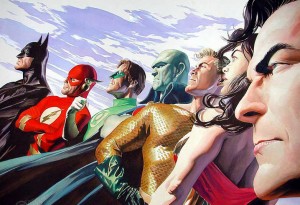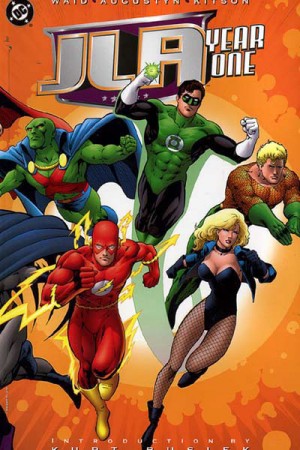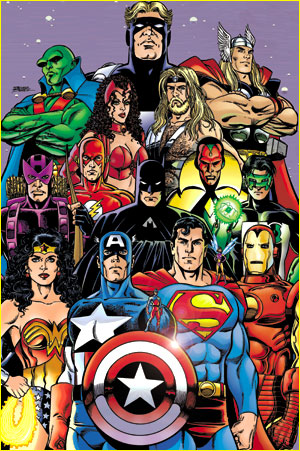 Although they may have not been the first super-hero team-up, DC’s Justice League is its most iconic. Not withstanding what the Marvel bullpen across town have done with the Avengers, the Justice League are the original super-hero super-group, even when they’re something less than the “Big 7.” Spawned out of the earlier super-team the Justice Society of America, the Justice League have eclipsed the JSA and become the flagship team book of the DCU since early on its history.
Although they may have not been the first super-hero team-up, DC’s Justice League is its most iconic. Not withstanding what the Marvel bullpen across town have done with the Avengers, the Justice League are the original super-hero super-group, even when they’re something less than the “Big 7.” Spawned out of the earlier super-team the Justice Society of America, the Justice League have eclipsed the JSA and become the flagship team book of the DCU since early on its history.
Over the years the Justice League has evolved, expanded, and on a couple occasions even been defunct for a time. With all those stories to go through, it’s a daunting task to find where to start without getting lost — or worse yet — disenfranchised. With Where Do I Start?, we come in and pinpoint the big 6 of the DC’s Big 7. Keep in mind we’re not counting various related teams like Justice Society of America or Justice League International — those deserve their own entry later on this year.
 JLA: Year One: Taking a cue from the seminal Batman: Year One, this 12-issue series shows Mark Waid, Brian Augustyn and Barry Kitson barreling into the founding year’s of DC’s resident super-hero team. This isn’t the JLA’s first origin (or its last, if you’re reading Johns & Lee’s Justice League), but JLA: Year One has been the one to beat since it was first published. Waid & Augustyn really show how the team is as much about the personal dynamics between the group as the universe-sized threats they faced. The one glaring flaw is the omission of Wonder Woman from the group, but the expert approach to this makes me almost forget about her.
JLA: Year One: Taking a cue from the seminal Batman: Year One, this 12-issue series shows Mark Waid, Brian Augustyn and Barry Kitson barreling into the founding year’s of DC’s resident super-hero team. This isn’t the JLA’s first origin (or its last, if you’re reading Johns & Lee’s Justice League), but JLA: Year One has been the one to beat since it was first published. Waid & Augustyn really show how the team is as much about the personal dynamics between the group as the universe-sized threats they faced. The one glaring flaw is the omission of Wonder Woman from the group, but the expert approach to this makes me almost forget about her.
DC: The New Frontier: Taking the Justice League back to the 60s in which it was spawned to tell this super-hero period piece was a stroke of genius by cartoonist Darwyn Cooke. Unlike other heroes that seem perpetually trying to stay away from their early origins, DC: A New Frontier shows how coming of age in the 60s really showcases the diverse origins and impact these characters can have. Green Lantern Hal Jordan is firmly in focus here, but my vote for best characterization is Wonder Woman.
JLA: Rock of Ages: Although Grant Morrison came onto JLA in a flash, it wasn’t until later arcs that he really began to settle in and deliver breakout work. The “Rock of Ages” arc is the first real intersection of Morrison’s wilder fringe work like The Invinsibles with his unabashed love for super-hero comics, mixing Lex Luthor, Metron, baby universes and the Philosopher’s Stone. Despite being labored by a cast that includes variants of famous heroes (Electric Superman!), the book stands on its own as a epic in JLA history.
 Kingdom Come: Although billed as a universe-spanning story, Waid & Alex Ross are actually did an encompassing JLA epic with the blockbuster Kingdom Come series. Set 20 years in the future where the original JLA have largely passed the baton to a new generation of heroes, rising turmoil and unrest bring grey-haired Superman, an aged Batman and others to get the band back together and do what they do best. This series really revives the majesty of DC’s heroes, one of the things that sets them apart from Marvel and other hero universes.
Kingdom Come: Although billed as a universe-spanning story, Waid & Alex Ross are actually did an encompassing JLA epic with the blockbuster Kingdom Come series. Set 20 years in the future where the original JLA have largely passed the baton to a new generation of heroes, rising turmoil and unrest bring grey-haired Superman, an aged Batman and others to get the band back together and do what they do best. This series really revives the majesty of DC’s heroes, one of the things that sets them apart from Marvel and other hero universes.
Justice League of America: The Greatest Stories Ever Told: Early Justice League stories have a varied track record of quality, but this streamlined collection hits upon most of the early highpoints and is a steal for under $20. Featured in it is the team breaking up, betrayal from the inside, and the inspiration behind the mind-bending Identity Crisis from a few years back. It also includes Keith Giffen, J.M. DeMattieus & Kevin Maguire’s comedy-tinged relaunch of the title from the mid 80s that became so popular it split off into its own title that echoes to this day. This book is a good book to have if you want to get a taste of the JLA’s early years.
JLA/Avengers: How can a seminal JLA book be the same one in which they’re sharing space with their cross-company rivals the Avengers? By showing just how different they are. Kurt Busiek and George Perez team up to deliver what has become one of the pinnacles of their career — and of both teams — with a universe-jumping crossover that still has time for intimate character moments.


I think one of the best things going for the JLA is you don’t have to read anything to know what’s going on when it’s written well. They’re not collected in any nice series of trades, but the issues from 120-200 are the best. Plenty of cross-overs with Earth-2, lots of time spent at the round table handling “JLA business” which is a lot better than it sounds. Plus they battle all their arch-nemesis for the first time in DCs modern era.
I would recommend “Justice League: A Midsummer’s Nightmare” TPB by Mark Waid, which reintroduced the Big 7 back in 1996, and the subsequent series by Gran Morrison. The whole Morrison run is great, but be sure to get “New World Order” TPB by Morrison (also collected in JLA Vol. 1, which has issues 1-9!), which features the Hyperclan story. What is interesting is the similarities between JL:AMN and NWO – some plot elements are alarmingly similar.
I really didn’t like Year One when I read it (years ago). I know it’s popular but I found it dull. I’d replace it wih Tower of Babel (yes I know that’s really a Batman story, but it’s good Waid JLA).
Rock of Ages … sigh … so good.
Allow me to say this as respectfully as possible, it appears that the author of the piece is too reliant on relatively recent trade paperbacks and doesn’t show a commanding knowledge of the title. For instance Ron is a huge X-Men guy, and ad such I would submit that his wealth of knowledge spans the entire line both original team and the reformed team that began in the 70’s. A number of articles in this column appear to rely too heavily on recent collections instead of taking the entire run of a book into account. This was not a criticism of the author or his work, simply an observation.
It isn’t going to do too much good to suggest “deep cuts” of Justice League stories, especially if they’re not available. This is a place to start, with trades and collections that are basic and available.
@k5blazer
I believe the purpose of a “Where Do i Start?” article is not to give people the “greatest hits” of a particular title, its more to show them which stories serve as the best introduction to the characters, somewhere to get your foot in the door. It’s geared towards somebody who wants to sample a title and see if it’s for them. With that as the goal, recent trades would be the place to go, as they are readily available and can introduce the characters. If the person reading it decides they like what they read, they can then dig deeper and find the more hard to find, though still great, stories that you are speaking of.
I completely disagree with New Frontier and Kingdom Come being new reader friendly. Most of the fun came from seeing how the characters were changed for the setting, and they don’t always match up with their current-day counterparts.
The obvious one missing from the list is Grant Morrison and Frank Quietly’s Earth 2. The big 7 are showcased excellently here and the Crime Syndicate really helps explain what the JLA characters are all about.
I haven’t read New Frontier, just saw the movie. But I do agree with you that Kingdom come might not be the best place to start. I think it will be a better, more rewarding reading experience if you have a decent understanding of the characters before you read it. It does stand on it’s own, but if somebody were to read all the books on this list, I think Kingdom Come should be read last. (Although it is amazing, don’t get me wrong.)
I think now is the best time to start JLA. Go get issue #1.
If you can find a copy…
Available on Comixology. Grant Morrison JLA is on there too.
Wow I own all but ONE of the books recommends. That rarely happens
Great list. I really would’ve suggested the entire Grant Morrison Justice League run, but narrowing it to one trade makes financial sense. I wouldn’t argue with a single entry on this list, save to say I’d add JLA: One Million just for the pure fun it gave to the DCU for the month it existed.
Given the relaunch, I was convinced this story would have been tongue in cheek about starting at Justice League #1. Good list as is, I’ve read a few of the stories but intend to pick up some of the others.
haha. I was going to say the exact same thing.
I”m going to agree with the reviewer here almost 100%, these are all good additions to a JLA fan’s collection of TPBs. I also agree with DavidTobin that Kingdom Come really did call for a pretty extensive knowledge of the DCU. However, Waid & Ross’ book is a classic and like WATCHMEN should be on any fanboy (or gal) ‘must have’ list.
i’ve liked most of the JLA stuff, i just like seeing all these heroes together
Almost perfect… The only change I would make to this list is replacing JLA: Year One with JLA: Earth 2.